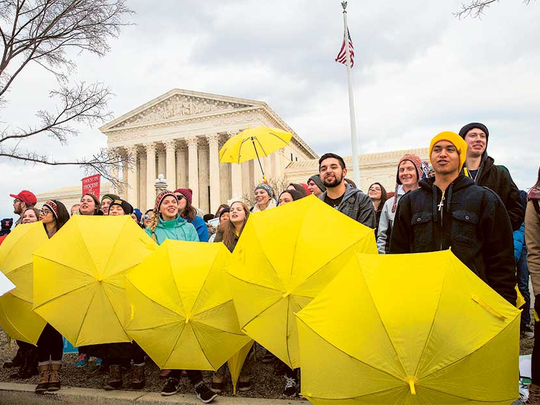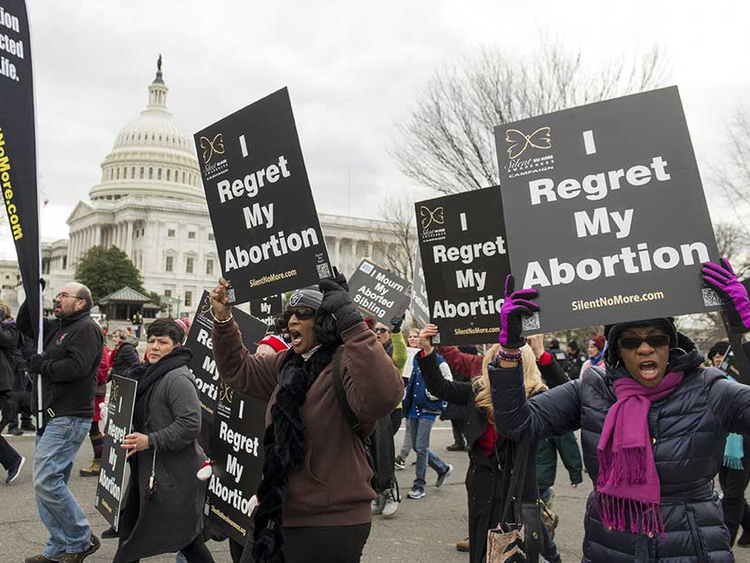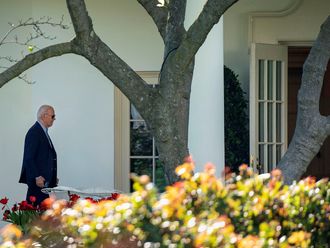
WASHINGTON: After more than four decades, the March for Life has become a familiar ritual in Washington. No matter the weather, thousands of abortion opponents gather every year on the National Mall, many wearing matching hats or scarves from their school or church groups, and listen to speeches from social conservatives in Congress before marching to the Supreme Court.
The presence of metal detectors and uniformed Secret Service agents was one of many signs that this year was different.
The anti-abortion movement has political momentum on its side, and Vice-President Mike Pence lent his newly minted star power to Friday’s rally, promising the triumphant crowd that more victories await.
“We’ve come to a historic moment in the cause for life,” said Pence. “Life is winning in America.”
Pence and White House senior adviser Kellyanne Conway pledged that President Donald Trump would keep his promises to end taxpayer-funded abortion and to choose a Supreme Court justice in the mould of the late Antonin Scalia, a conservative Catholic who opposed abortion.
Pence, who describes himself as an “evangelical Catholic”, has spoken at the march before, during his time in Congress. But during Barack Obama’s eight years as president, abortion opponents could point to few policy achievements at the federal level.
The election of Trump brought new energy to the march, and while the National Park Service does not provide crowd estimates, the turnout was clearly bigger than in recent years.
“President Trump will make a real difference,” said Marc Crotty, 62, an information-technology consultant from Rockville, Maryland, who attends the march every year. “We’ve had a strongly pro-abortion president for eight years.”
One of Trump’s first acts after taking office a week ago was to sign an executive order banning US aid to foreign groups that provide abortions.
Domestically, a budget provision known as the Hyde Amendment already bans federal funding for Medicaid coverage of most abortions. Conservatives would like to see the rule made into a permanent law.
Trump stance
Majority Republicans in the House and Senate would also like to end federal funding for Planned Parenthood, which provided more than a third of the nation’s abortions in 2014. They also hope to ban most abortions after 20 weeks of pregnancy. Trump has pledged to sign both measures if they reach his desk.
Some people at the march said they did not support Trump initially or disagreed with him on other issues but voted for him because of his stance on abortion and his ability to prevent a liberal majority on the Supreme Court.
“I wouldn’t say that I was a supporter of Donald Trump,” said Glenn Miller, 60, a cabinet maker from Coventry, Connecticut. “I didn’t think I had a choice.”
Other participants said they felt the march was important this year because their voices were not represented at last week’s Women’s March on Washington, an anti-Trump demonstration that drew massive crowds in Washington and cities around the country. The women’s march included support for abortion rights in its mission statement and dropped an anti-abortion group as a partner.
Joi Hulecki, 63, a nurse practitioner from Orlando, Florida, said abortion-rights supporters wrongly portray the decision to terminate a pregnancy as empowering for women, when in fact women often feel pressured to have abortions and regret it later.
“We consider ourselves pro-women too,” she said.
Deeply divided
The March for Life — held every year on or near the anniversary of the 1973 Supreme Court decision legalising abortion — was never expected to attract a crowd on the scale of the women’s march, which brought more than half a million people to Washington. Organisers said in their permit application that they expected 50,000 people, though they hoped for more.
“There’s been a lot of talk about numbers this past week,” said Jeanne Mancini, president of the March for Life. “It’s hard to add up so many numbers after 44 years because there have been a lot of us.”
Mancini added that the most important number for marchers was 58 million, an estimate for the number of abortions performed in the United States since 1973.
Americans remain deeply divided on abortion. The latest Gallup survey, released last spring, found that 47 per cent of Americans described themselves as pro-abortion rights and 46 per cent as anti-abortion. It also found that 79 per cent believed abortion should be legal in either some or all circumstances.
Ilyse Hogue, president of NARAL Pro-Choice America, said that poll shows why abortion-rights supporters should not despair.
“The vast majority of Americans support Roe v. Wade and support the legal right to abortion,” Hogue said.
The March for Life, however, is running ads arguing that a majority of Americans support some restrictions on abortion and don’t believe it should be funded by tax dollars.












